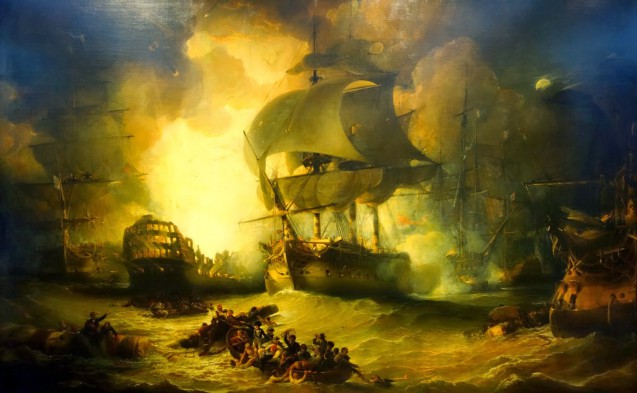The Orient has always fascinated westerners; how many young readers have not had their imaginations inflamed by the tales of One Thousand and One Nights? In 1798, the French government, the Directory, was particularly interested in Egypt, an important country on the English trade route to India. The Directory sought to improve its own trade, exploit the developing links with Egypt and its wealth, whilst at the same time disrupt England’s trade in the Mediterranean and India. Napoleon Bonaparte and his army were dispatched to conquer Egypt.
Arrival in Egypt and the first victories
The warships commanded by Bonaparte left Toulon, a Mediterranean port on the south coast of France, bound for Egypt. On the way, they captured the small island of Malta, which lies off the coast of Sicily. The ships arrived in Alexandria, taking the city, on 2 July, and the troops disembarked, heading for Cairo.
In the shadow of the Pyramids, the French army came up against the Mamluks. These elite horsemen, in the service of the Egyptian rulers, the Beys, were formidable slave-soldiers who fought on horseback. They were brave and strong fighters, but collectively they lacked organization and discipline and Napoleon succeeded in defeating them. Bonaparte’s battle tactics were highly effective: he formed his troops into a square, with the cavalry and supplies at the centre and his artillery and muskets on the outside, repelling the Mamluk attacks. After this victory, the French troops had further success at Damietta (6 August) and Salalieh (11 August).
Difficult times in Egypt
The French soldiers wore a thick wool uniform, and the stifling Egyptian heat made life very uncomfortable for them. Sand got everywhere: in clothes, bags and hair. The soldiers also experienced mirages in the desert. These mirages, optical illusions created by light, gave the impression that there were water sources on the horizon. Water was actually very difficult to find, and even when sources were found, the water from them was often undrinkable.
The doctors who accompanied the troops on the expedition were quickly over-run as the men were struck down by illnesses and diseases brought about by the climate. Sunstroke, diarrhea and eye problems that led rapidly to blindness were common. The doctors were forced to use Dromedary camels to transport the sick and wounded.
The conquest of Syria
On 1 August, 1798, Bonaparte learned that the British navy, commanded by Admiral Nelson, had sunk the French fleet which was sitting in the port of Abukir. He and his troops were now stranded in Egypt! They would have to wait a long time before new ships could be dispatched from France to pick them up. During this time, Napoleon set about reorganizing the country that he had just conquered.
The population in Cairo was not happy with the heavy taxes imposed on them by the invading forces. On 21 October, 1798, encouraged by the British naval victories and driven by their displeasure at the occupying forces, the local chiefs led an uprising against the French. The French, in reaction, violently quashed this revolt. Many rebels were killed and in the resulting battles, many scientific instruments and equipment were destroyed and a number of the mosques were damaged.
Around the same time, the French were victorious at Sediman on 7 October, 1798, and at Samhoud on 22 January, 1799.
Bonaparte left to conquer Syria and face the Turkish Sultan who had arrived to take back his Egyptian territory. The French troops were victorious at El-Arich, Gaza and Jaffa but there were also bloody massacres. To shock and terrify the opposing troops, many soldiers taken prisoner were executed. As well as these violent measures, many soldiers were also struck down with plague and died. The French troops soon arrived at Acre, and laid siege to the city. However, despite eight attempts, the fortress resisted all French attacks and Bonaparte and his troops were forced to retreat.
On route back to Cairo, Bonaparte once again came up against the Turkish army, this time supported by British troops. He had very few soldiers at his disposal, but was still victorious in what became known as the Battle of Abukir (25 July, 1799). This victory went some way to making up for the embarrassing defeat of the French navy at the Battle of Abukir Bay in 1798.
However, Bonaparte also received news that the political situation in France was extremely fragile. He decided to return home, perhaps even to take power! On the night of 22 August, 1799, Bonaparte left Egypt in secret so as not to upset his soldiers. After a few months at sea, he arrived in France on 9 October, 1799. He left General Kléber in charge of his troops in Egypt. Although victorious at the Battle of Heliopolis on 20 March 1800, he was assassinated a few months later. General Menou took over. Due to his conversion to Islam, he became known as General Abdallah Menou. However, the defeats began to stack up and the French eventually capitulated (surrendered) on 2 September, 1801, at Alexandria. What remained of the French army was evacuated on British ships.
Illustrations
Top: Bonaparte haranguant l’armée avant la bataille des Pyramides (detail) by Antoine-Jean Gros, Château de Versailles © RMN
Middle (upper): portrait of a Mamluk by the painter and draughtsman Nicolas Toussaint, Musée de l’Armée © RMN
Middle (lower): two French soldiers riding camels rather than horses, Bataille d’Aboukir (detail) by François Lejeune, Château de Versailles © RMN
Bottom: portrait of General Kléber by Joseph Ansiaux, Château de Versailles © RMN
Go to: “Bonaparte in Egypt (part 2): the scientific expedition“
Pauline Lefebvre, March 2009 (tr. & ed. H.D.W.)


